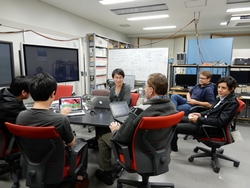Physics
Overview of the Department
The Department of Physics has more than 130 faculty members. They are all internationally recognized researchers who cover almost all of the frontier fields of physics, such as Condensed-Matter Physics, Cosmology, Particle Physics, Nuclear Physics and General Physics. We have the longest history among Japanese universities concerning education and research in physics, while turning out many outstanding physicists, including Leo Esaki (1973 Nobel laureate), Ryogo Kubo (1977 Boltzmann Medal), Yoichiro Nambu (2008 Nobel laureate), Masatoshi Koshiba (2002 Nobel laureate), and Takaaki Kajita (2015 Nobel laureate) over the past century. Our Department is one of the world's largest and top-ranked graduate schools in physics.
http://www.phys.s.u-tokyo.ac.jp/en/index.html
Description of Major Research Groups
Condensed-Matter Physics
In the experimental condensed-matter group, we aim to explore novel quantum phases formed by ensembles of electrons, atoms and molecules in materials, and to understand their properties microscopically. Our playgrounds include, for example, superconductivity, topological quantum phases, correlated electron systems, quantum magnetism and mesoscopic systems. The development of new experimental probes, such as advanced spectroscopy using photons from synchrotron radiation and free-electron lasers, as well as characterization under extreme conditions (ultra-low temperature, ultra-high magnetic field, vacuum, and pressure) are also our important experimental research areas.
Magnetism and superconductivity are typical co-operative phenomena caused by the interaction of electrons and nuclei in crystals. Theoretical condensed-matter physics aims to understand such interesting phenomena in condensed-matter from the basic principles of physics and interactions between constituent particles. We also pursue methodological development for that purpose. The research field of theoretical condensed-matter physics is further expanding due to recent developments of new experimental techniques, like highly accurate electron spectroscopy or laser cooling, as well as large-scale computer simulations.
Particle and Nuclear Physics
We are studying atomic nuclei and elementary particles, the fundamental constituents of the observable matter in the universe, using cutting-edge experimental technologies and accelerators. To explore phenomena at both large and small scales, our research necessarily considers various topics. In particular, basic questions are being addressed: Why does matter have mass? How was the universe created? How can we understand strong interactions, and what are the mechanisms responsible for synthesizing the variety of elements on Earth? What are the limits where beautiful symmetries arise or break down?
In theoretical particle physics, we conduct research to address fundamental questions concerning the origin of space-time and matter. Some concrete examples of our focus are: Physics beyond the standard model; Particle cosmology, such as dark matter and inflation; Superstring, M-theory, quantum gravity, supersymmetric gauge theory; Mathematical physics related to quantum field theory, such as duality and integrability; Quantum foundation -- the conceptual and mathematical underpinnings of quantum theory. Research on theoretical nuclear physics includes exotic nuclei, novel shell structures, quark-gluon matter in and out of equilibrium, and astrophysical applications.
Astrophysics and Cosmology
Astrophysics aims to (1) understand the origin and evolution of the universe, and (2) explore physics under extreme conditions, such as high temperature, high density, and strong magnetic fields. We conduct experimental and observational studies using ground-based, underground, and space-borne facilities. Multi-messenger observations through electromagnetic waves, cosmic rays, neutrinos and gravitational waves allow us to reveal the exciting nature of the Universe.
Topics of theoretical research include the evolution of the universe, the formation of stars and black holes, and the nature of dark matter and dark energy. To this end, we utilize observational data and computer simulations as well as a broad range of theoretical physics, such as particle physics, general relativity, plasma physics, atomic and molecular physics, fluid mechanics, and celestial dynamics. We also explore novel methods for data analysis of gravitational-wave detection, for exascale computing, and for developing turbulence theory.
General Physics / Biophysics
The research fields of Experimental General Physics cover laser physics and spectroscopy, plasma physics, and the physics of non-equilibrium systems. In laser physics and spectroscopy, we study novel quantum states of matter, light-matter interactions in strong optical fields, and the spectroscopy of various systems, including atoms, molecules, nanoparticles, semiconductor nanostructures, and biological molecules. In plasma physics, nonlinear dynamics and collective phenomena in non-equilibrium plasmas are studied in order to realize nuclear fusion. The physics of living matter and out-of-equilibrium systems are studied, which are relevant to biophysics and soft matter.
A living organism is a complex system consisting of many layers, but it is composed of both physical and fundamental constituents. Therefore, it should be possible to understand the principles governing life in term of physics. From this viewpoint, biophysics aims for a general integrated understanding of biological phenomena through the methodologies of physics, by resolving a living organism into its elements, such as molecules and cells, and by considering it as a system in which the elements interact with each other. We are conducting theoretical and experimental research on the physics at many layers, such as molecules, supermolecules, cells, nerves, and the brain.



